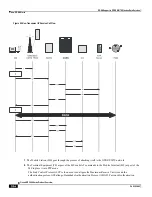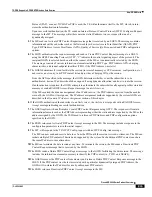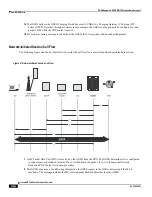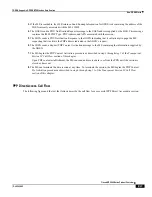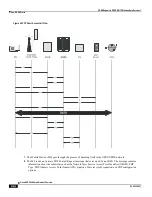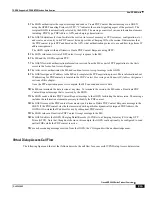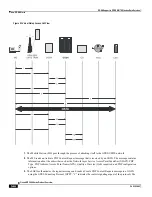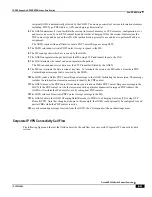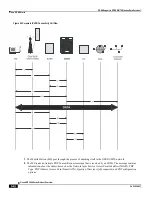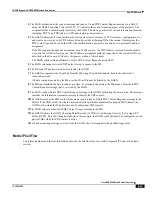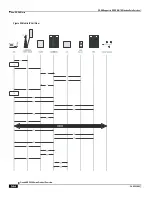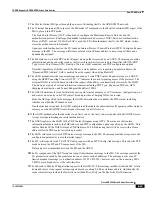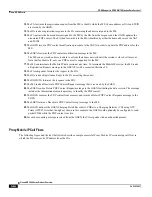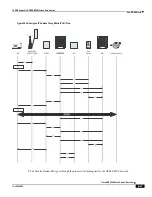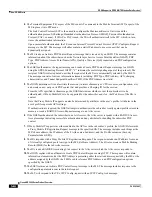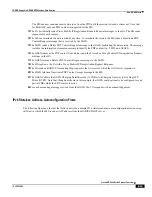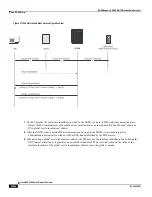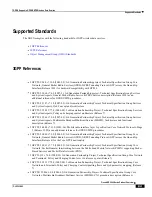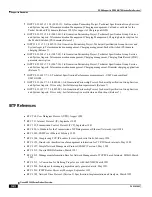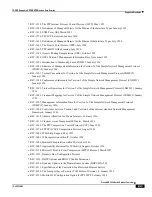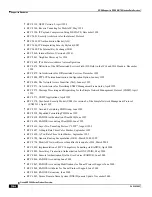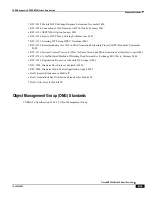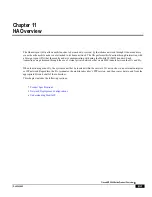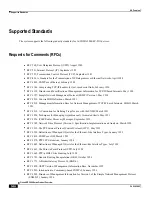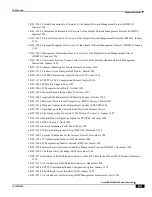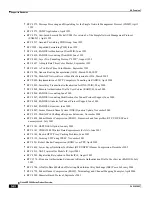
GGSN Support in GPRS/UMTS Wireless Data Services
▀ How GGSN Works
▄ Cisco ASR 5000 Series Product Overview
OL-22938-02
2.
The Terminal Equipment (TE) aspect of the MS sends AT commands to the Mobile Terminal (MT) aspect of the
MS to place it into PPP mode.
The Link Control Protocol (LCP is then used to configure the Maximum-Receive Unit size and the
authentication protocol (Challenge-Handshake Authentication Protocol (CHAP), Password Authentication
Protocol (PAP), or none). If CHAP or PAP is used, the TE will authenticate itself to the MT, which, in turn,
stores the authentication information.
Upon successful authentication, the TE sends an Internet Protocol Control Protocol (IPCP) Configure-Request
message to the MT. The message will either contain a static IP address to use or request that one be
dynamically assigned.
3.
The MS sends an Activate PDP Context Request message that is received by an SGSN. The message contains
information about the subscriber such as the Network layer Service Access Point Identifier (NSAPI), PDP
Type, PDP Address, Access Point Name (APN), Quality of Service (QoS) requested, and PDP configuration
options.
4.
The SGSN authenticates the request message and sends a Create PDP Context Request message to a GGSN
using the GPRS Tunneling Protocol (GTPC, ―C‖ indicates the control signaling aspect of the protocol). The
recipient GGSN is selected based on either the request of the MS or is automatically selected by the SGSN.
The message consists of various information elements including: PDP Type, PDP Address, APN, charging
characteristics, and Tunnel Endpoint Identifier (TEID, if the PDP Address was static).
5.
The GGSN determines if it can facilitate the session (in terms of memory or CPU resources, configuration, etc.)
and creates a new entry in its PDP context list and provides a Charging ID for the session.
From the APN specified in the message, the GGSN determines whether or not the subscriber is to be
authenticated, if Proxy Mobile IP is to be supported for the subscriber, and if so, the IP address of the HA to
contact.
Note that Proxy Mobile IP support can also be determined by attributes in the user‘s profile. Attributes in the
user‘s profile supersede APN settings.
If authentication is required, the GGSN attempts to authenticate the subscriber locally against profiles stored in
memory or send a RADIUS Access-Request message to an AAA server.
6.
If the GGSN authenticated the subscriber to an AAA server, the AAA server responds with a RADIUS Access-
Accept message indicating successful authentication and any attributes for handling the subscriber PDP
context.
7.
If Proxy Mobile IP support was either enabled in the APN or in the subscriber‘s profile, the GGSN/FA forwards
a Proxy Mobile IP Registration Request message to the specified HA. The message includes such things as the
MS‘s home address, the IP address of the FA (the care-of-address), and the FA-HA extension (Security
Parameter Index (SPI)).
8.
The HA responds with a Proxy Mobile IP Registration Response. The response includes an IP address from one
of its locally configured pools to assign to the MS (its Home Address). The HA also creates a Mobile Binding
Record (MBR) for the subscriber session.
9.
The HA sends a RADIUS Accounting Start request to the AAA server which the AAA server responds to.
10.
The GGSN replies with an affirmative Create PDP Context Response using GTPC. The response will contain
information elements such as the PDP Address representing either the static address requested by the MS or the
address assigned by the GGSN, the TEID used to reference PDP Address, and PDP configuration options
specified by the GGSN.
11.
The SGSN returns an Activate PDP Context Accept message to the MS. The message includes response to the
configuration parameters sent in the initial request.
12.
The MT, will respond to the TE‘s IPCP Config-request with an IPCP Config-Ack message.
Содержание ASR 5000 Series
Страница 1: ......
Страница 26: ......
Страница 48: ...New In Release 10 0 SCM Features Cisco ASR 5000 Series Product Overview OL 22938 02 ...
Страница 50: ......
Страница 58: ......
Страница 67: ...Product Service and Feature Licenses Default Licenses Cisco ASR 5000 Series Product Overview OL 22938 02 ...
Страница 68: ......
Страница 126: ......
Страница 138: ......
Страница 146: ......
Страница 218: ......
Страница 236: ......
Страница 356: ......
Страница 374: ......
Страница 422: ......
Страница 496: ......
Страница 572: ......
Страница 654: ......
Страница 700: ......
Страница 726: ......
Страница 784: ......
Страница 816: ......
Страница 839: ...Network Address Translation Overview How NAT Works Cisco ASR 5000 Series Product Overview OL 22938 02 ...
Страница 841: ...Network Address Translation Overview How NAT Works Cisco ASR 5000 Series Product Overview OL 22938 02 ...
Страница 844: ......
Страница 906: ......
Страница 926: ......
Страница 942: ......
Страница 943: ...Cisco ASR 5000 Series Product Overview OL 22938 02 Chapter 30 Technical Specifications ...
Страница 966: ......
Страница 967: ...Cisco ASR 5000 Series Product Overview OL 22938 02 Chapter 31 Safety Electrical and Environmental Certifications ...
Страница 972: ......

